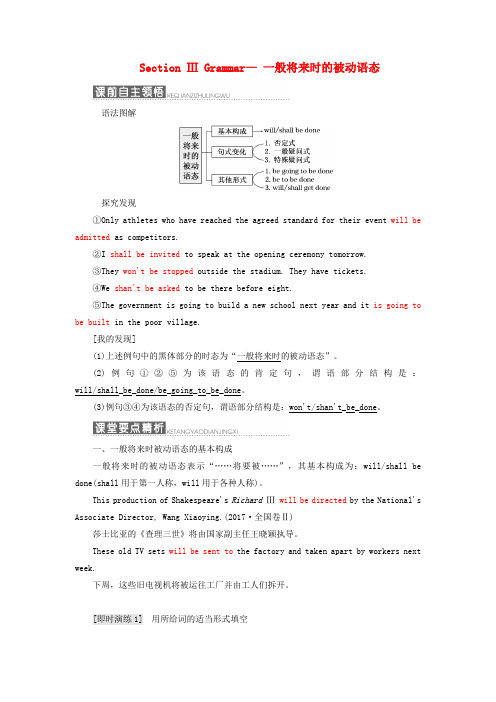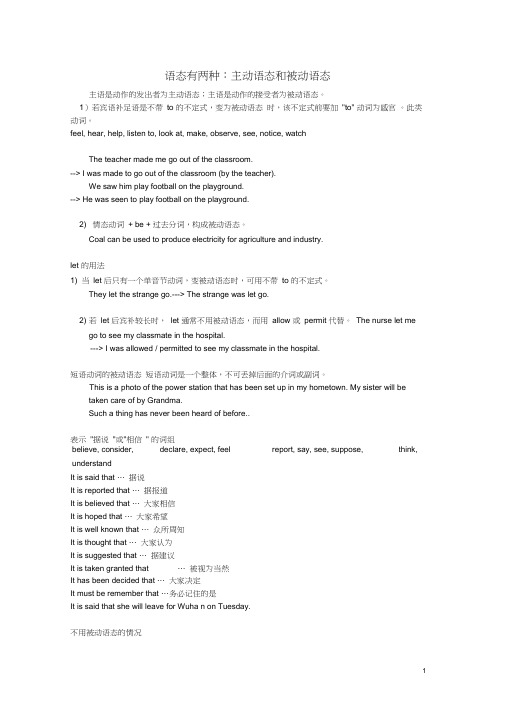新人教版学高中语法专题被动语态教案必修英语 解析版
高中英语新人教版精品教案《被动语态》3

被动语态一,定义:英语的语态是通过动词的形式表现出来的,用来表明主语与谓语动词之间的关系,英语的动词有两种语态形式,即主动语态和被动语态。
如果主语是动作的执行者,谓语动词用主动语态。
如果主语是动作的对象,谓语动词用被动语态。
例:The 英语由他们讲。
主语“英语”是“讲”的承受者,是被动句,动词用被动语态的形式。
二,被动语态的构成1、Be(am/i/are/wa/were)及物动词的过去分词构成动词的被动语态的形式。
Be动词有人称、数和时态的变化,其变化规则与be作为系动词的变化完全一样。
例:The aeThe mone are coed in the ooThee boo were ied him →He wa ied b Tom主动结构的主语变为介词b的宾语,组成介词短语,放在被动结构中谓语动词之后。
主动语态、被动语态两种时态要保持一致。
(2)将动词改为"be过去分词"。
The hed a meeting eterda → A meeting wa hed b them eterda他们昨天开会了。
(3)将主动语态的主语放在谓语动词后。
注意:如果原主语是代词,则应由主格变为宾格。
He ang a ong →A ong wa ung b him三,各种时态的被动语态1、一般现在时:am/i/are 过去分词We are taught Engih b her由她教我们英语。
2、一般过去时:wa/were过去分词A e b Mar玛丽给了我一件礼物。
3、一般将来时:wi be过去分词The de wi be mended b him这张桌子将由他修理。
4、现在进行时:am/i/are being 过去分词The wa are being ae of wood2 The Engih ong ____________ing b the gir3 The meeting _______________hed tomorrow morning4 The fower __________________water b Mr Green5 The ga _____________brea b him eterda evening。
浙江省高中英语语法被动语态教案新人教版必修

浙江省高中英语语法被动语态教案新人教版必修一、教学目标1. 让学生理解被动语态的概念和用法。
2. 培养学生运用被动语态进行有效沟通的能力。
3. 帮助学生掌握被动语态的构成和转换方法。
二、教学内容1. 被动语态的定义和分类。
2. 被动语态的构成和转换。
3. 被动语态的用法和注意事项。
三、教学重点与难点1. 重点:被动语态的构成和用法。
2. 难点:被动语态的转换和运用。
四、教学方法1. 任务型教学法:通过小组合作、角色扮演等活动,让学生在实践中运用被动语态。
2. 案例分析法:分析日常生活中的被动语态实例,帮助学生理解和掌握。
3. 互动式教学法:引导学生参与课堂讨论,提高学生的参与度和积极性。
五、教学过程1. 导入:通过一个简单的被动语态例子,激发学生的兴趣,引出本课主题。
2. 讲解:详细讲解被动语态的定义、分类、构成和转换方法。
3. 练习:设计不同难度的练习题,让学生巩固所学内容。
4. 应用:分组进行角色扮演,运用被动语态进行交流。
6. 作业:布置相关练习题,让学生课后巩固。
六、教学评价1. 评价方式:课堂参与度、练习完成情况、角色扮演表现。
2. 评价标准:能否正确运用被动语态进行沟通,能否灵活转换被动语态。
七、教学拓展1. 对比主动语态和被动语态的用法和情境。
2. 介绍被动语态在不同文体中的应用,如新闻、小说、科学文章等。
八、教学资源1. 教材:新人教版高中英语必修教材。
2. 辅助材料:被动语态PPT、练习题、角色扮演剧本等。
3. 网络资源:相关被动语态的英语学习网站、视频、文章等。
九、教学建议1. 针对不同学生的学习程度,适当调整教学内容和难度。
2. 鼓励学生积极参与课堂活动,提高他们的自信心和兴趣。
3. 注重课后辅导,及时解答学生的疑问。
十、教学反思2. 根据学生的反馈,调整教学方法和策略。
3. 不断充实自己的专业知识,提高教学水平。
请根据实际教学需要调整和补充具体内容。
希望对您有所帮助!重点和难点解析一、教学目标2. 补充说明:通过设计具有针对性的教学活动,确保学生能够深入理解被动语态的概念和用法,并在实际语境中正确运用。
高中英语Unit3ComputersSectionⅢGrammar_现在完成时的被动语态教案含解析新人教版必修2

Section Ⅲ Grammar—现在完成时的被动语态语法图解探究发现①Over time I have been changed quite a lot.②Since the 1970s many new applications have been found for me.③The important problem has been discussed for nearly two weeks.④The ink has not been removed from the clothes.⑤Haven't your problem been solved?⑥How many buildings have been built in your school?[我的发现](1)以上例句中都使用了现在完成时的被动语态。
(2)以上例句中第①②③句是该时态的肯定句式;第④句是否定句式;第⑤句是一般疑问句式;第⑥句是特殊疑问句式。
一、结构Already this year, 115 measles cases have been reported in the USA, compared with 189 for all of last year.(2017·北京高考)今年美国已经报告了115例麻疹病例,而去年全年共189例。
The construction of the bridge has not been finished.桥的建设还没有完成。
Has the date for the next meeting been decided?下次会议的日期已决定了吗?How long has the battery not been changed?电池多久没有更换了?[即时演练1](1)变换句子The children have already been told the good news.①将上面的句子变为否定句。
高中英语Unit2TheOlympicGamesSectionⅢGrammar—一般将来时的被动语态教案(含解析)新人教版必修2

Section Ⅲ Grammar—一般将来时的被动语态语法图解探究发现①Only athletes who have reached the agreed standard for their event will be admitted as competitors.②I shall be invited to speak at the opening ceremony tomorrow.③They won't be stopped outside the stadium. They have tickets.④We shan't be asked to be there before eight.⑤The government is going to build a new school next year and it is going to be built in the poor village.[我的发现](1)上述例句中的黑体部分的时态为“一般将来时的被动语态”。
(2)例句①②⑤为该语态的肯定句,谓语部分结构是:will/shall_be_done/be_going_to_be_done。
(3)例句③④为该语态的否定句,谓语部分结构是:won't/shan't_be_done。
一、一般将来时被动语态的基本构成一般将来时的被动语态表示“……将要被……”,其基本构成为:will/shall be done(shall用于第一人称,will用于各种人称)。
This production of Shakespeare's RichardⅢwill be directed by the National's Associate Director, Wa ng Xiaoying.(2017·全国卷Ⅱ)莎士比亚的《查理三世》将由国家副主任王晓颖执导。
浙江省高中英语语法被动语态教案新人教版必修

浙江省高中英语语法被动语态教案新人教版必修一、教学目标1. 让学生理解被动语态的概念和用法。
2. 培养学生正确运用被动语态进行表达的能力。
3. 提高学生对英语语法的兴趣和积极性。
二、教学内容1. 被动语态的构成:be + 过去分词2. 被动语态的用法:表示动作的承受者。
3. 被动语态的时态和语态变化。
三、教学重点与难点1. 重点:被动语态的构成和用法。
2. 难点:被动语态的时态和语态变化。
四、教学方法1. 任务型教学法:通过完成各种任务,让学生在实践中学习和运用被动语态。
2. 交际式教学法:通过小组讨论和角色扮演,让学生在实际语境中运用被动语态。
3. 语法讲解与练习相结合:先讲解被动语态的规则,进行相应的练习。
五、教学过程1. 导入:通过图片或情境引导学生思考被动语态的必要性。
2. 讲解:讲解被动语态的构成、用法和时态语态变化。
3. 练习:设计不同难度的练习题,让学生巩固所学知识。
4. 任务:布置实际语境的任务,让学生运用被动语态进行表达。
5. 总结:对本节课的内容进行总结,强调重点和难点。
6. 作业:布置相关的家庭作业,巩固所学知识。
这五个章节的内容仅供参考,具体实施时可以根据实际教学情况进行调整。
教案的内容要结合教材和学生的实际情况,以提高学生的英语语法水平为目标。
六、教学评价1. 通过课堂观察,评价学生在被动语态运用上的表现。
2. 通过练习和任务完成情况,评价学生对被动语态的掌握程度。
3. 鼓励学生进行自我评价和同伴评价,提高他们的自我意识和反思能力。
七、教学拓展1. 对比主动语态和被动语态的用法,分析它们在特定情境下的优劣。
2. 探讨被动语态在各种文体的应用,如新闻、小说、科技文章等。
3. 引导学生关注被动语态在实际生活中的运用,提高他们的语感。
八、教学资源1. 教材:新人教版高中英语必修教材。
2. 辅助材料:被动语态的相关文章、练习题和任务素材。
3. 多媒体设备:用于展示图片、视频和情境素材。
高考英语语法复习被动语态学案新人教版

语态有两种:主动语态和被动语态主语是动作的发出者为主动语态;主语是动作的接受者为被动语态。
1)若宾语补足语是不带 to 的不定式,变为被动语态 时,该不定式前要加 "to" 动词为感官动词。
feel, hear, help, listen to, look at, make, observe, see, notice, watchThe teacher made me go out of the classroom.--> I was made to go out of the classroom (by the teacher).We saw him play football on the playground.--> He was seen to play football on the playground.2) 情态动词 + be + 过去分词,构成被动语态。
Coal can be used to produce electricity for agriculture and industry.let 的用法1) 当 let 后只有一个单音节动词,变被动语态时,可用不带 to 的不定式。
They let the strange go.---> The strange was let go.2) 若 let 后宾补较长时, let 通常不用被动语态,而用 allow 或 permit 代替。
The nurse let me go to see my classmate in the hospital.--- > I was allowed / permitted to see my classmate in the hospital.短语动词的被动语态 短语动词是一个整体,不可丢掉后面的介词或副词。
This is a photo of the power station that has been set up in my hometown. My sister will be taken care of by Grandma.Such a thing has never been heard of before..表示 "据说 "或"相信 " 的词组It is said that … 据说It is reported that … 据报道It is believed that … 大家相信It is hoped that … 大家希望It is well known that … 众所周知It is thought that … 大家认为It is suggested that … 据建议It is taken granted that … 被视为当然It has been decided that … 大家决定It must be remember that …务必记住的是It is said that she will leave for Wuha n on Tuesday.不用被动语态的情况。
人教版高中英语必修2-现在完成时的被动语态用法讲解(教师版)(推荐文档)

【高一同步教程】高中英语必修2 现在完成时的被动语态用法讲解【学习目标】1. 现在完成时被动语态的结构2. 现在完成时被动语态的主要用法3. 使用现在完成时的被动语态需要注意的问题【课前预习】1. 什么是语态?语态是表示主语和动词之间的主动关系或被动关系的动词形式。
英语动词有两种语态: 主动语态和被动语态。
主动语态表示主语是动作的执行者(施动者), 被动语态表示主语是动作的承受者(受动者)。
2. 对现在完成时被动语态的理解现在完成时被动语态的结构就是现在完成时态和被动语态结构的叠合, 即“ have + been + 动词过去分词”。
试比较以下几组句子的谓语结构:1)主动句: He has repaired the machine for two hours.他修理这台机器已有两小时了。
被动句: The machine has been repaired for two hours. 这台机器已修了两小时了。
2)主动句: The teacher has borrowed the books. 老师把那些书借走了。
被动句:The books have been borrowed by the teacher. 那些书被老师借走了。
【教学过程】一、现在完成时被动语态的构成1. 现在完成时被动语态的肯定式由“have /has +been +及物动词的过去分词”构成。
例如:Two windows have been broken. 两个窗子被打破了。
2. 现在完成时被动语态的否定式由“have /has +not+been +及物动词的过去分词”构成。
例如:The car has not been repaired. 这辆汽车还没有修好。
3. 现在完成时被动语态的一般疑问式由“Have /Has +主语+been+及物动词的过去分词”构成。
例如:①─Has her work been finished?她的工作完成了吗?─Yes, it has.是的, 完成了。
浙江省高中英语语法被动语态教案新人教版必修

浙江省高中英语语法被动语态教案新人教版必修一、教学目标1. 让学生掌握被动语态的构成和用法。
2. 培养学生运用被动语态进行有效沟通的能力。
3. 提高学生对英语语法的认识和运用水平。
二、教学内容1. 被动语态的构成:be + 过去分词2. 被动语态的用法:表示动作的承受者。
3. 被动语态的常见时态和语态变化。
三、教学重点与难点1. 重点:被动语态的构成和用法。
2. 难点:被动语态的时态和语态变化。
四、教学方法1. 任务型教学法:通过完成具体任务,引导学生理解和运用被动语态。
2. 交际型教学法:通过情景对话,培养学生运用被动语态进行实际交流的能力。
3. 案例分析法:分析典型例句,帮助学生掌握被动语态的用法。
五、教学过程1. 导入:以日常生活中的例子引出被动语态的概念,激发学生的兴趣。
2. 讲解:讲解被动语态的构成、用法和常见时态语态变化。
3. 练习:设计不同难度的练习题,让学生巩固所学内容。
4. 任务:分组完成任务,运用被动语态进行实际交流。
5. 总结:对本节课的内容进行归纳总结,强调重点和难点。
6. 作业:布置相关作业,让学生进一步巩固被动语态的知识。
六、教学评估1. 课堂问答:通过提问检查学生对被动语态的理解和掌握程度。
2. 练习批改:及时批改练习题,了解学生对被动语态的掌握情况。
3. 任务完成情况:评估学生在任务中的表现,了解其运用被动语态的能力。
七、教学拓展1. 对比主动语态和被动语态:分析两者在意义和用法上的差异。
2. 被动语态在不同语境中的应用:探讨被动语态在日常生活、新闻报道等不同语境中的运用。
3. 被动语态的特殊情况:介绍一些特殊的被动语态结构,如“被动态的被动语态”。
八、教学策略调整1. 根据学生的反馈,及时调整教学进度和难度。
2. 针对学生的薄弱环节,进行有针对性的辅导。
3. 鼓励学生主动参与课堂,提高其学习积极性。
九、教学反思1. 总结本节课的教学效果,反思教学过程中的不足之处。
- 1、下载文档前请自行甄别文档内容的完整性,平台不提供额外的编辑、内容补充、找答案等附加服务。
- 2、"仅部分预览"的文档,不可在线预览部分如存在完整性等问题,可反馈申请退款(可完整预览的文档不适用该条件!)。
- 3、如文档侵犯您的权益,请联系客服反馈,我们会尽快为您处理(人工客服工作时间:9:00-18:30)。
1被动语态的构成形式⒈被动语态的基本时态变化被动语态通常为十种时态的被动形式,被动语态由be+过去分词构成,be随时态的变化而变化。
以do 为例,各种时态的被动语态形式为:(1)am/is/are + done(过去分词)一般现在时(2)has /have been done 现在完成时(3)am/is /are being done现在进行时(4)was/were done 一般过去时(5)had been done 过去完成时(6)was/were being done 过去进行时(7)shall/will be done 一般将来时(8)should/would be done 过去将来时(9)shall/will have been done将来完成时(少用)(10)should/would have been done 过去将来完成时(少用)⒉被动语态的特殊结构形式1带情态动词的被动结构。
其形式为:情态动词+be+过去分词。
如:The baby should be taken good care of by the baby—sitter.2有些动词可以有两个宾语,在用于被动结构时,可以把主动结构中的一个宾语变为主语,另一宾语仍然保留在谓语后面。
通常变为主语的是间接宾语。
如:His mother gave him a present for his birthday.可改为He was given a present by his motherfor his birthday.3当“动词+宾语+宾语补足语”结构变为被动语态时,将宾语变为被动结构中的主语,其余不动。
例:Someone caught the boy smoking a cigarette.可改为The boy was caught smoking a cigarette.4在使役动词have,make,get 以及感官动词see,watch,notice,hear,feel,observe等后面不定式作宾语补语时,在主动结构中不定式to要省略,但变为被动结构时,要加to。
如:Someone saw a stranger walk into the building.可改为A stranger was seen to walk into the building.5有些相当于及物动词的动词词组,如“动词+介词”,“动词+副词”等,也可以用于被动结构,但要把它们看作一个整体,不能分开。
其中的介词或副词也不能省略。
例:The meeting is to be put off till Friday.⒊非谓语动词的被动语态v.+ing 形式及不定式to do也有被动语态(一般时态和完成时态)。
例:I don't like being laughed at in the publiC.2如何使用被动语态学习被动语态时,不仅要知道被动语态的各种语法结构,还要知道在哪些情况中使用被动语态。
⒈讲话者不知道动作的执行者或不必说出动作的执行者(这时可省by短语)。
如:My bike was stolen last night.⒉借助被动的动作突出动作的执行者。
如:I was given ten minutes to decide whether I should accept the offer.⒊为了更好地安排句子。
例:The wellknown person got on the bus and was immediately recognzed by people.(一个主语就够了)3It is said that从句及其他类似句型一些表示“据说”或“相信”的动词如believe,consider,expect,report,say,suppose,think等可以用于句型“It+be+过去分词+that从句”或“主语+be+过去分词+to do sth.”的有:It is said that 据说It is reported that 据报道It is believed that 大家相信It is hoped that 大家希望It is well I known that 众所周知It is thought that 大家认为It is suggested that 据建议如:It is said that the boy has passed the national exam.(=The boy is said to have passed the national exam.4谓语动词的主动形式表示被动意义⒈英语中有很多动词如break,catch,clean,drive,lock,open,sell,read,write,wash等,当它们被用作不及物动词来描述主语特征时,常用其主动形式表达被动意义,主语通常是物。
如:This kind of cloth washes well.注意:主动语态表被动强调的是主语的特征,而被动语态则强调外界作用造成的影响。
试比较:The door won't lock.(指门本身有毛病)The door won't be lockeD.(指不会有人来锁门,指“门没有锁”是人的原因)⒉表示“发生、进行”的不及物动词和短语,如:happen,last,take place,break out,come out,come about,come true,run out,give out,turn out等以主动形式表示被动意义。
如:How do the newspapers come out?这些报纸是如何引出来的呢?⒊系动词没有被动形式,但有些表示感受、感官的连系动词feel,sound,taste,book,feel等在主系表结构中常以主动形式表示被动意义。
如:Your reason sounds reasonable.5非谓语动词的主动形式表被动意义在某些句型中可用动名词和不定式的主动形式表被动意义。
⒈在need,want,require,bear等词的后面,动名词用主动形式表示被动意义,其含义相当于动词不定式的被动形式。
如:The house needs repairing(to be repaired).这房子需要修理。
⒉形容词worth后面跟动名词的主动形式表示被动含义,但不能跟动词不定式;而worthy后面跟动词不定式的被动形式。
如:The picture—book is well worth reading.(=The picture—book is very worthy to be reaD.)⒊动词不定式在名词后面作定语,不定式和名词之间有动宾关系时,又和句中另一名词或代词构成主谓关系,不定式的主动形式表示被动含义。
如:I have a lot of things to do this afternoon.(to do与things是动宾关系,与I 是主谓关系。
)⒋在某些“形容词+不定式”做表语或宾语补足语的结构中,句子的主语或宾语又是动词不定式的逻辑宾语时,这时常用不定式的主动形式表达被动意义。
这些形容词有nice,easy,fit,hard,difficult,important,impossible,pleasant,interesting等。
如:This problem is difficult to work out.(可看作to work out 省略了for me).⒌在too…to…结构中,不定式前面可加逻辑主语,所以应用主动形式表示被动意义。
如:This book is too expensive (for me)to buy.⒍在there be…句型中,当动词不定式修饰名词作定语时,不定式用主动式作定语,重点在人,用被动形式作定语,重点在物。
如:There is no time to lose(to be lost).(用to lose 可看成for us to lose;用to be lost,谁lost time不明确。
)⒎在be todo结构中的一些不定式通常应用主动表主动,被动表被动。
然而,由于古英语的影响,下列动词rent,blame,let等仍用不定式的主动形式表示被动意义。
例:Who is to blame for starting the fire?6介词in,on,under等+名词构成介词短语表被动意义表示方位的介词与含动作意义的名词合用,含被动之义,其意义相当于该名词相应动词的被动形式,名词前一般不用冠词。
⒈"under +名词”结构,表示某事在进行中”常见的有:under control(受控制)under treatment(在治疗中)under repai(在修理中)under discussiorn(在讨论中)under construction(在施工中)如:The building is under construction(is being constructed).⒉“beyond+名词\"结构,“出乎…….胜过…、范围、限度”常见的有:beyond belief(令人难以置信)beyond one's reach(鞭长莫及)beyond one's control(无法控制)beyond our hope.我们的成功始料不及如:The rumour is beyond belief=cant be believeD.⒊"above+名词”结构,表示(品质、行为、能力等)超过……高于……"如:His honest character is above all praise=His honest character cannot be praised enough.⒋for+名词“结构,表示“适于……为着……”如:for sale(出售),for rent(出租)等。
That house is for sale.(=That house is to be sold).⒌“n+名词“结构,表示“在…….过程中或范围内“常见的有:in print(在印刷中)in sight在视野范围内)如:The book is not yet in print(=is not yet printed)⒍"on+名词”结构,表示“在从事……中”常见的有:on sale(出售)on show(展出)on trial(受审)如:Today some treasures are on show in the museum(=are being showed).⒎“out of+名词”结构;表示“超出……之外常见的有:out of control(控制不了)out of sight(超出视线之外)out of one's reach(够不着)out of fashion(不流行)如:The plane was out of control (can't be controlled)。
